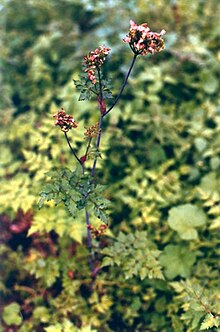Angelica sinensis, commonly known as dong quai (simplified Chinese: 当归; traditional Chinese: 當歸; pinyin: dāngguī; Jyutping: dong1 gwai1; Pe̍h-ōe-jī: tong-kui) or female ginseng, is a herb belonging to the family Apiaceae, indigenous to China. Angelica sinensis grows in cool high altitude mountains in East Asia. The yellowish brown root of the plant is harvested in the fall and is a well-known Chinese medicine which has been used for thousands of years.[3]
| Angelica sinensis | |
|---|---|

| |
| Scientific classification | |
| Kingdom: | Plantae |
| Clade: | Tracheophytes |
| Clade: | Angiosperms |
| Clade: | Eudicots |
| Clade: | Asterids |
| Order: | Apiales |
| Family: | Apiaceae |
| Genus: | Angelica |
| Species: |
A. sinensis
|
| Binomial name | |
| Angelica sinensis | |
| Synonyms[2] | |
| |
This section needs more reliable medical references for verification or relies too heavily on primary sources. Please review the contents of the section and add the appropriate references if you can. Unsourced or poorly sourced material may be challenged and removed. Find sources: "Angelica sinensis" – news · newspapers · books · scholar · JSTOR (May 2018)
|
Angelica is hardy to 5 °C (41 °F)[4] and can be cultivated at elevations of 1,500 to 3,000 metres (5,000–10,000 ft). Seedlings need to be kept out of direct sunlight, but the mature plant can withstand it. Angelica requires deep moist fertile soil and is perennial if prevented from going to seed.[4]
The dried root of A. sinensis – commonly known as Chinese angelica (Chinese: 當歸; pinyin: dāngguī; Pe̍h-ōe-jī: tong-kui) – is widely used in traditional Chinese medicine, although there is insufficient evidence that it has any medicinal effect.[5]
There is evidence that A. sinensis may affect the muscles of the uterus. Women who are pregnant or planning on becoming pregnant should not use A. sinensis, because it may induce a miscarriage.[5] Taking A. sinensis can cause skin to become extra sensitive to the sun, leading to a greater risk for skin cancer.[5]
A. sinensis may increase the anticoagulant effects of the drug warfarin (as it contains coumarins[6]) and consequently increase the risk of bleeding.[7]
Due to the antiplatelet and anticoagulant effects of A. sinensis, it should be taken with caution with herbs or supplements (such as ginkgo, garlic, and ginger) that may slow blood clotting to reduce the possible risk of bleeding and bruising.[5][8]
The plant's chemical constituents include phytosterols, polysaccharides, ligustilide, butylphthalide, cnidilide, isocnidilide, p-cymene, ferulate, and flavonoids.[9]
Media related to Angelica sinensis at Wikimedia Commons